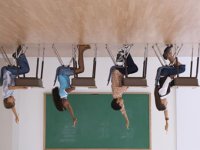5 Tips for Flipping Your PBL Classroom
Your content has been saved!
Go to My Saved Content.I am of course a huge project-based learning (PBL) nerd and advocate. I am also an advocate for the flipped classroom, yet at the same time I also have my concerns about flipping a classroom. This model still hinges upon great teachers, and engaging curriculum and instruction. So why not combine PBL and the flipped classroom? It can be an excellent match when you consider some of the following tips. Even Salman Khan believes that the flipped classroom can create the space for PBL.
1. Short Content Videos
The key piece here is short. Kids do not want to be watching hours of content. However, short five- to ten-minute videos could be used to replace lectures in the classroom and free up space for more PBL time. These videos might be introductions to learning the content, or possibly content review. Students who enjoy the flipped classroom often comment that their favorite part is being able to watch videos over and over again as needed. Find or create these videos, and make sure to align them to the significant content you intend to teach and assess in your PBL project.
2. Collaborative Virtual Work
I love it when students assign their own homework. Many times in a PBL project, the team might not quite finish all they want to do in class, and some of this work relies on collaboration. There are many digital tools out there that allow for collaboration, and this could be your chance to "flip the collaboration," whether it's joint research and documentation, or even reflection as a group. This virtual work can also be great documentation for assessing collaboration as one of the 4 C's in the 21st century learning aspect of a PBL project.
3. Virtual Labs and Games
Flipping isn't just videos, because -- let's be honest -- videos can get boring after a while. As you go through the PBL process with students, use other types of virtual activities as both components to learn content and a means of formative assessment. For example, if students need to learn about parts of the body, use an interactive digital lab for them to do a dissection. Or, if students are learning about some math component, have them play a math game outside of the brick-and-mortar setting that still allows you, as the teacher, to check on how they're doing.
4. Product Production
If you are concerned with students taking an excessive amount of time in actually constructing the PBL product, give a technology choice or choices as an element of the final product. These products can be produced and edited in the cloud, where individual students and teams can have access to them 24/7. You can ask students for these links and give them your feedback to help improve their work.
5. Consider Tech Equity
Not all of our students have access the technology. Some of us are lucky enough to have 1:1 classrooms, but not all. Because of that, you need to truly consider equity as a core issue if you intend to flip your PBL classroom. It's difficult for students to collaborate digitally, for example, if some have access to the technology while others do not. In cases like this, consider your flipped components as optional for those students able to use them.
PBL and the flipped classroom model can play well together. In fact, PBL can make it better when students are engaged in authentic work and given voice and choice in how and what they want and need to learn. What are some of the ways you've used both the flipped classroom and PBL? How do you see them complementing each other?
